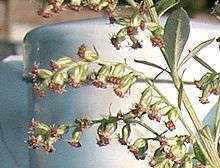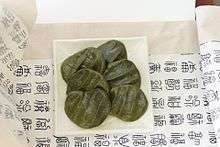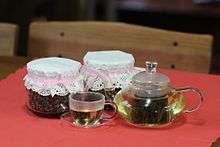Artemisia princeps
| Artemisia princeps | |
|---|---|
 | |
| Scientific classification | |
| Kingdom: | Plantae |
| Clade: | Angiosperms |
| Clade: | Eudicots |
| Clade: | Asterids |
| Order: | Asterales |
| Family: | Asteraceae |
| Genus: | Artemisia |
| Species: | A. princeps |
| Binomial name | |
| Artemisia princeps Pamp. | |
| Synonyms[1] | |
| |
Artemisia princeps, also called ssuk,[2] Korean wormwood,[2] Korean mugwort,[3] and Japanese mugwort in English, is an Asian plant species in the sunflower family, native to China, Japan, and Korea.[4] It is a perennial, very vigorous plant that grows to 1.2 meters. This species spreads rapidly by means of underground stolons and can become invasive. It bears small, buff-colored flowers from July to November which are hermaphroditic, and pollinated by wind.[5] The leaves are feather shaped, scalloped and light green, with white dense fuzz on the underside.
Uses
Culinary
Leaves and young seedlings can be eaten raw or cooked.[6] They can also be used in salads and soups after removal of the bitterness.
Japan
In Japan it is called yomogi (蓬) and the leaves are sometimes blanched and added to soups or rice.[7] Its leaves, along with those of hahakogusa, are a fundamental ingredient in kusa mochi (literally "grass cake"), a Japanese confectionery, to which it imparts its fresh, springlike fragrance and vivid green coloring.[8]
The young leaves can be lightly boiled before being pounded and added to glutinous rice dumplings known as mochi to which they give a pleasant colour, aroma and flavour.[9][10] Mugwort mochi can be found in many North American health food stores.[9]
Japanese mugwort is used to make a tea called yomogi-cha ("mugwort tea.") It is said to have detox effects and help with healthy pregnancy. [11] It is often served when serving hittsumi noodles [12]
Korea
It is also widely used in Korean cuisine and also as medicine.[13] It is used for making tteok (rice cake),[14] jeon (Korean style pancake), ssuk kimchi, (쑥김치), ssukguk (쑥국, soup made with ssuk) and so forth.
Medicinal
Artemisia princeps is one of the species of mugwort used as moxa in Moxibustion,[15] a traditional medical practice of China, Japan, Korea, Mongolia, Tibet, Nepal and Vietnam. An evaluation of the efficacy of the smoke and water extracts of the herb found that both preparations inhibited the growth of a specific line of breast cancer cells in vitro.[16] Phenolics from A. princeps (caffeoylquinic acids (CQA) such as 3-CQA (chlorogenic acid), 4-CQA, 5-CQA (neochlorogenic acid), 1,5-diCQA, 3,4-diCQA, 3,5-diCQA and 4,5-diCQA) alleviated the oxidative stress and enhanced the viability of certain neuronal cells in vitro.[17]
China
In China it is known as huanghua ai (黄花艾, literally yellow-flower mugwort).[18]
In culture
Myth
Korea
In Korea, it is called ssuk (쑥) or tarae ssuk (타래쑥)[18] which is deeply related to Dangun Sinhwa (단군신화), legend of Gojoseon, the first Korean kingdom. To ancient people in Korea, ssuk was one of the food that was believed to have medicinal or religious value.[19] In the foundation myth of Gojoseon in 2333 BCE, eating nothing but 20 cloves of garlic and a bundle of ssuk for 100 days let a bear be transformed into a woman.[19]
See also
References
- ↑ The Plant List Artemisia princeps Pamp.
- 1 2 Korea National Arboretum (2015). English Names for Korean Native Plants (PDF). Pocheon: National Arboretum. p. 361. ISBN 978-89-97450-98-5. Archived from the original (PDF) on 25 May 2017. Retrieved 24 December 2016 – via Korea Forest Service.
- ↑ Chung, Hye Kyung; Bae, Eun Kyong; Ji, Hee Jung; Hwang, Jung Suk; Park, Dong Woon; Kim, Jung Eun; Jung, Hwa Jin; Choi, Hyun Ju; Lee, Dong Seok (2003). "An oligosaccharide fraction from Korean mugwort herb suppresses death of the mouse thymocytes in culture by down-regulating the Fas death receptor gene". Biotechnology Letters. 25 (18): 1549–1553. doi:10.1023/A:1025482516404. ISSN 0141-5492.
- ↑ Flora of China Vol. 20-21 Page 704 魁蒿 kui hao Artemisia princeps Pampanini, Nuovo Giorn. Bot. Ital., n.s.,. 36: 444. 1930.
- ↑ "Artemisia princeps - Pampan". Plants For A Future Database. Retrieved 2008-01-18.
- ↑ Kunkel. G. Plants for Human Consumption. Koeltz Scientific Books 1984 ISBN 3-87429-216-9
- ↑ Hosking, Richard (January 1997). A Dictionary of Japanese Food. Tuttle Publishing. p. 175. ISBN 978-0-8048-2042-4.
- ↑ Takahashi, Masumi; Natsuko Hosokawa; Keiko Mori. "Yomogi (Mugwort)". Japan Through Young Eyes. Archived from the original on 15 February 2008. Retrieved 2008-01-18.
- 1 2 Facciola. S. Cornucopia - A Source Book of Edible Plants. Kampong Publications 1990 ISBN 0-9628087-0-9
- ↑ Plants for a Future Database Archived July 10, 2011, at the Wayback Machine.
- ↑ "よもぎ茶 効能|便秘を解消し美肌に効果が! 1日1包で33円!".
- ↑ From the Source - Japan (Lonely Planet)
- ↑ "쑥【Ssuk】" (in Korean). National Institute of Agricultural Science and Technology of South Korea.
- ↑ Food in Korea : Korean Food Culture
- ↑ Ryuzo, Oda (2000). "The Advantages and Disadvantages of Artemisia princeps and A. montana". Japanese Journal of History of Pharmacy. 35 (1): 55–62. Retrieved 2008-01-18.
- ↑ Artemisia princeps var orientalis Induces Apoptosis in Human Breast Cancer MCF-7 Cells
- ↑ Lee, SG; Lee, H; Nam, TG; Eom, SH; Heo, HJ; Lee, CY; Kim, DO (2011). "Neuroprotective effect of caffeoylquinic acids from Artemisia princeps Pampanini against oxidative stress-induced toxicity in PC-12 cells". Journal of Food Science. 76 (2): C250–6. doi:10.1111/j.1750-3841.2010.02010.x. PMID 21535743.
- 1 2 Takeatsu Kimura; Paul P. H. But; Ji-Xian Guo; Chung Ki Sung (1996). International Collation of Traditional and Folk Medicine: Northeast Asia. World Scientific. pp. 159p. ISBN 978-981-02-2589-6.
- 1 2 Pettid, Michael J. (2008). Korean Cuisine: An Illustrated History. London: Reaktion Books. p. 12. ISBN 978-1-86189-348-2.




